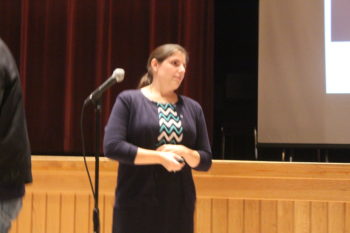Photo: Participants at last week’s community path feasibility study view alternative routes on poster boards.
The one message the consultants conducting the Belmont Community Path Feasibility Study wanted to convey to residents attending last week’s public meeting on building a path through Belmont was that any discussion would stay within the bounds of “respectful civil discourse.”
The need for such a reminder came as the study ventured into the proposed path’s most contentious “eastern” section from Belmont Center to Brighton Street. For the past three decades, Channing Road homeowners whose property lines have abutted a strip of land adjacent the MBTA’s commuter rail line have resisted calls from the bike and recreational campaigners who have sought to build a community path along the route.
And it turned out that just a few sparks from the approximately 60 residents who turned up to the Chenery Middle School auditorium. Rather, the public was more interested in what was being presented than debating the plans … just yet.
“[The study] is a collaboration” of all residents and interest groups, said Kathleen Fasser, principal at K3 Landscape Architecture in Concord which is working with Pare Corp., hired by the town to conduct the feasibility study.

Pare Corp’s Amy Archer.
Under the firm and business-like leadership of Pare’s Chief Planner Amy Archer, the consulting team revealed five alternatives routes:
- Running on mostly land owned by the Belmont Citizens Forum along the north side of the MBTA commuter line tracks,
- On the south side of the MBTA commuter line, hugging the back of Belmont High School.
- A path in a “linear park” on a redesigned Concord Avenue,
- One that meanders through the Belmont High property midway between C0ncord Avenue and the tracks, and
- Using public roads in the Winn Brook neighborhood.
A detailed map and description of the five routes can be viewed in the feasibility study here.
You can see the path options for the western end of the route – from the Waltham line to the Department of Public Works site – here and the central section from the DPW to the commuter bridge in Belmont Center here.
Underpass in the mix
The study also includes several design plans for an underpass running about 50 feet from the end of Alexander Avenue under the commuter rail tracks and onto school property near Harris Field and the JV baseball diamond.
The pedestrian tunnel, first proposed and supported by town officials in the 1970s, would allow for a direct link from the Winn Brook neighborhood to community areas such as the high school and its playing fields, the Underwood Pools, the skating rink, the library and the Wellington Elementary School.
Archer also presented three crossing designs at Brighton Road – where a new path will likely cross the commuter rail tracks to meet an existing bike route that runs to Alewife MBTA station – that includes a pair of pedestrian bridges that would be well above the roadway and require long ramps on both sides of Brighton.
After presenting the five options, Archer said each path alternative was ranked and evaluated after a series of public engagements that included public meetings and two site visits in which the public and engineers walked the proposed paths.
Archer said the team had surveyed residents with 40 to 45 questions on what’s the most important feature of the roadway. While not a single feature rose to the top, a pair – that the path makes community connections and it brings high-quality recreation to the town – were on 70 percent of the surveys.
Archer pointed out that one important measure that has not been included in the calculations is the cost estimate for each route. But that was deliberate since the consultants wanted to determine town stakeholders’ preferences absent a bill in hand.
Public responses to the routes included questions and comments concerning the contentious issue from the previous public meeting that focused on how community path users would transverse Concord Avenue at the commuter rail bridge entering Belmont Center.
Sue Bass of upper Concord Avenue felt that attempting to add pedestrians and bike riders onto the current “free-for-all” of vehicle traffic at the tunnel “would kill people.”
Archer acknowledged that difficulty, pondering if a solution such as traffic lights or a traffic circle – called a “roundabout” – could be attempted.
“We are dying to do a traffic study there,” said Archer.
Other comments focused on whether to invest in snow removal equipment for the path or make it a nine months facility, the issue of people driving to the route and parking along residential streets and the danger of placing a path that intersects with side streets.
Next up on the schedule will be the final public meeting during the initial stage which will focus on “Hot Topics” – issues raised during the three previous gatherings – on Wednesday, Dec. 7 at 7 p.m. at the Chenery Middle School.








Leave a Review or Comment